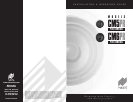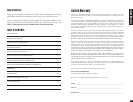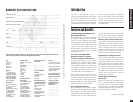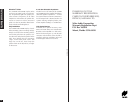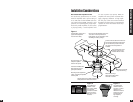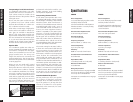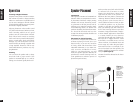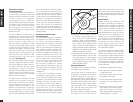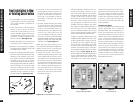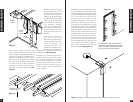
18
Specifications
Specifications
CM5PR
Driver Compliment
5-1/4" talc-filled polypropylene woofer
with butyl-rubber surround
3/4" fluid-cooled ultra-wide dispersion
Kaladex
®
tweeter in a custom pivoting
coaxial enclosure
Recommended Amplifier Power
10 to 100 watts per channel
Nominal Impedance
4 or 8 ohm selectable
Frequency Response
65Hz to 20kHz, +/- 3dB (on axis)
Tweeter Adjustment
Up to 20° pivot angle
Sensitivity
88dB for 2.83 volts of Pink Noise
Overall Exterior Frame Dimensions
8-1/8" diameter
Depth Behind Wall
3-3/8" deep (based on 1/2" drywall)
Wall Cut-Out Dimensions
6-7/8" diameter
Wiring Requirements
We recommend 16 to 18 gauge stranded
wire for up to 80 feet, 14 gauge stranded
wire for up to two hundred feet.
Connectors accommodate 12 to 18 gauge
stranded wire.
CM6PR
Driver Compliment
6-1/2" talc-filled polypropylene woofer
with butyl-rubber surround
3/4” fluid-cooled ultra-wide dispersion
Kaladex
®
tweeter in a custom pivoting
coaxial enclosure
Recommended Amplifier Power
10 to 125 watts per channel
Nominal Impedance
4 or 8 ohm selectable
Frequency Response
60Hz to 20kHz, +/- 3dB (on axis)
Tweeter Adjustment
Up to 20° pivot angle
Sensitivity
89dB for 2.83 volts of Pink Noise
Overall Exterior Frame Dimensions
9-1/4" diameter
Depth Behind Wall
3-3/4" deep (based on 1/2" drywall)
Wall Cut-Out Dimensions
8" diameter
Wiring Requirements
We recommend 16 to 18 gauge stranded
wire for up to 80 feet, 14 gauge stranded
wire for up to two hundred feet.
Connectors accommodate 12 to 18 gauge
stranded wire.
Incorporating a Local Volume Control
In a multiroom system there is one indis-
pensible device for true convenience—a
local volume control. It enables you to
adjust the volume of the speakers without
leaving the room.
Plan to wire the system so that each pair
of speakers has its own volume control
built into the wall (think of a volume con-
trol as a dimmer switch for sound).
Niles makes a wide range of high perfor-
mance indoor and outdoor volume con-
trols. They are available in Standard or
Decora
®
style cover plates (just like your
light switches and dimmers). Volume con-
trols are connected in line with the speak-
er, so you must connect the wire from the
amplifier to the volume control and then
from the volume control to the speaker.
Speaker Wire
Use 2-conductor speaker wire when con-
necting CM5PR and CM6PR speakers to
your receiver or amplifier. For most appli-
cations, we recommend you use 16 or 18
gauge stranded wire. For wiring runs
longer than 80 feet we recommend 14
gauge stranded wire. The no-strip termi-
nals of the PR speakers will accommodate
12 to 18 gauge wire.
When you run wire inside walls, special
jacketing (CL-2 or CL-3) is required to
both protect the wire and for fire preven-
tion. In some areas conduit is required.
For a trouble-free installation, low voltage
wire such as speaker wire must be run in
accordance with the National Electrical
Code and any applicable provisions of the
local building code. If you are unsure of
the correct installation techniques, wire
jacket or type of conduit to use, consult a
professional audio/video installer, your
building contractor, or the local building
and inspection department.
Incorporating Remote Control
If your stereo system operates with a wire-
less Infrared (IR) remote control, consider
the advantages of installing a Niles Infrared
Extender System. Niles manufactures a
number of concealable IR sensors and wall
mounted keypads which send a copy of
your hand-held remote command via a
wire to your main equipment location,
where it is repeated to your stereo system.
The wire is typically installed with the
speaker wire, since the speaker signal and
the IR signal will not interfere with each
other. This makes almost no difference to
the installation time, and the cost of the
recommended IR control cable (West Penn
D291 or equivalent) is reasonable.
The correct routing for IR control cable is
to home run an IR control cable from the
main equipment location beside the
speaker wire to the planned volume con-
trol location; and then on to the proposed
sensor location. The combination of IR
control cable and speaker wire enables a
programmable Niles IntelliPad
®
to be
installed at a later date (the IntelliPad has a
convenient speaker mute feature in addi-
tion to automating and controlling your
stereo system). An IR sensor is best placed
where it is convenient for you to point the
hand-held remote. Both an IntelliPad and
an IR sensor can be connected in one
room with one home run IR control cable.
Insulation Behind The Speaker
For best performance from your speakers
lay a batten of fiberglass insulation
(example: R-19 un-batted insulation) on
top of the speaker. Try to keep the same
amount of insulation for each speaker,
particularly in the same room, for consis-
tent bass response.
5
Installation Considerations
TECH TIP
Wire size is expressed by
its AWG (American Wire
Gauge) number.The lower
the number, the larger the
wire, i.e. 12AWG isphysi-
cally larger than 14AWG.



